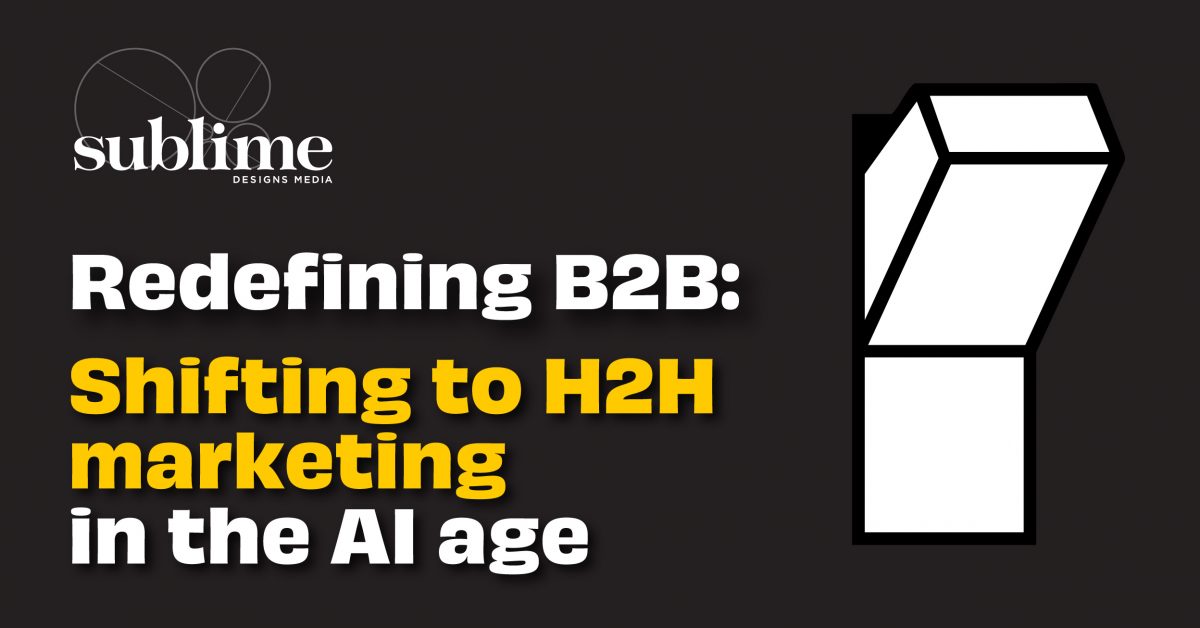People don’t follow businesses, they follow people. For decades, business-to-business (B2B) marketing relied on brand-to-brand communication, with polished messaging, corporate voice, and the logo doing the heavy lifting. But that playbook is showing its age.
At Sublime, we’re seeing firsthand how marketing is in the midst of a major transformation. The sheer volume of blogs, whitepapers, webinars, and now AI-generated content has created a tidal wave of noise (and yes, we realize the irony in pointing that out in a blog post of our own). At the same time, buyers can spot sugarcoating instantly and are quick to tune out anything that feels insincere. Add to that the decline in brand trust, as polished corporate messaging feels increasingly disconnected from reality, and it is clear why the old playbooks are no longer working.
What cuts through the noise isn’t a tagline or a campaign. It’s people. The future of business-to-business marketing isn’t B2B at all. It’s H2H: human-to-human. Here are a few more reasons why (if you aren’t convinced already):
- Businesses don’t buy, people do.
Even in B2B, decisions are made by individuals with emotions, priorities, and personal stakes. H2H marketing recognizes that and builds connections that resonate on a personal level, not just a corporate one. - Trust is the ultimate differentiator.
B2B sales cycles are long and complex. Buyers want partners they can trust, not just vendors with a product. When companies elevate real voices, whether it’s their employees, leaders, or other experts, it builds credibility in a way logos and taglines cannot. - It influences the pipeline.
Human-driven communication helps move deals forward. Prospects are more likely to engage when they see real people behind the brand, especially when evaluating trust and reliability. - Emotional connection drives loyalty.
At the end of the day, even B2B buyers want to feel understood. H2H marketing creates stronger relationships that lead to not just sales, but long-term partnerships. - It future-proofs marketing.
As AI accelerates the volume of generic content, the human element becomes the differentiator. Authentic voices will be what keeps brands relevant and trustworthy.
How to redefine B2B to H2H
So how can brands bring more humanity into their marketing?
- Identify voices within your company. Look for people who embody your company’s vision, values, and expertise. These might be executives, but they could just as easily be product managers, designers, or developers. The most powerful voices are often the ones closest to the work.
- Elevate and amplify those voices. Encourage your team to share their thoughts and experiences on platforms like LinkedIn. One standout example is the now-viral “burrito post”, which resonated not because it was part of a campaign, but because it was authentic, relatable, and memorable. People connected with the person behind the post, not the brand itself.
- Communicate with authenticity. Be real. Be vulnerable. Don’t be afraid to share challenges as well as successes. People respond to honesty, not perfection.
- Keep it short and meaningful. In an age of information overload, long-winded messages get lost. Add value quickly. Share insights that matter. Don’t make noise just to make noise.
Amid all the noise out there (and there is a lot of it), one thing remains clear: people still trust people.That’s why H2H marketing works. When employees and leaders share authentic voices, they build trust, cut through the clutter, and even help move deals forward.
The companies that succeed will be the ones that elevate their people and embrace authenticity, vulnerability, and even humor. Redefining B2B as H2H isn’t just a marketing trend; it’s the new standard for building trust and driving growth in the AI age.
Need some help humanizing your marketing? Let’s talk.
